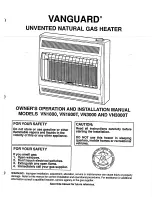
4
76683
Provisions for Adequate Combustion and Ventilation Air
The National Fuel Gas Code, ANSI Z223.1 defines a
confined space as a space whose volume is less
than 50 cubic feet per 1,000 Btu per hour (4.8m
3
per
kw) of the aggregate input rating of all appliances
installed in that space and an unconfined space as a
space whose volume is not less than 50 cubic feet
per 1,000 Btu per hour (4.8 m
3
per kw) of the aggre-
gate input rating of all appliances installed in that
space. Rooms communicating directly with the
space in which the appliances are installed, through
openings not furnished with doors, are considered a
part of the unconfined space.
WARNING: This heater shall not be installed in a
confined space or unusually tight construction unless
provisions are provided for adequate combustion
ventilation air.
Today's homes are built more energy efficient than ever. New
materials, increased insulation and new construction methods
help reduce heat loss in homes. Home owners weather strip
and caulk around windows and doors to keep the cold air out
and the warm air in. During heating months, home owners
want their homes as airtight as possible.
While it is good to make your home energy efficient, you need
fresh air. All fuel-burning appliances need fresh air for proper
combustion.
Supplying Adequate Ventilation
This appliance must be installed in an unconfined space.
The following information will help you classify your space
and provide adequate ventilation for complete combustion.
An Unconfined Space has a minimum volume of 50 cubic
feet for each 1000 BTU/Hr input rating of all appliances in the
space. (4.8 M
3
per kw), (cubic feet equals length x width x
height of space).
A Confined Space has a volume of less than 50 cubic feet
for each 1000 BTU/Hr input rating of all appliances in the
space, (4.8M
3
per kw), (cubic feet equals length x width x
height of space).
Determining if You Have a Confined or
Unconfined Space
Use this worksheet to determine if you have a confined or
unconfined space.
Space: Includes the room in which you will install heater plus
any adjoining rooms with doorless passageways or ventilation
grills between the rooms.
1. Determine the volume of the space (length x width x
height).
Length x Width x Height = _____cu. ft. (volume of space)
Example: Space size 25’ (length) x 25’ (width) x 8’ (ceiling
height) = 5,000 cu. ft. (volume of space)
If additional ventilation from adjoining room(s) is supplied
with grills or doorless openings, add the volume of these
rooms to compute the total volume of the applicable
space.
2. Divide the space volume by 50 cubic feet to determine the
maximum BTU/Hr the space can support.
________(volume of space)
÷
50 cu. ft. = (Maximum BTU/
Hr the space can support.
Example: 5,000 cu. ft. (volume of space)
÷
50 cu. ft. = 100
or 100,000 (maximum BTU/Hr the space can support)
3. Add the BTU/Hr of all gas burning appliances in the space.
Gas range
BTU/Hr
Vented gas heater
BTU/Hr
Gas fireplace logs
BTU/Hr
Other gas appliances* +
BTU/Hr
Total =
BTU/Hr
Example:
Gas range
60,000 BTU/Hr
Vent-free logs
+ 29,000 BTU/Hr
Total
= 89,000 BTU/Hr
*Do not include direct-vent gas appliances. Direct-vent draws
combustion air from the outdoors and vents to the outdoors.
4. Compare the maximum BTU/Hr the space can support
with the actual amount of BTU/Hr used.
__________ BTU/Hr (maximum the space can support)
__________ BTU/Hr (actual amount of BTU/Hr used)
Example: 100,000 BTU/Hr (max. the space can support)
89,000 BTU/Hr (actual amount of BTU/Hr used)
The space in the above example is an unconfined space
because the actual BTU/Hr used is less than the maximum
BTU/Hr the space can support. If the space had been
confined, your options would be as follows:
A. Rework worksheet, adding the space of an adjoining
room. If the extra space provides an unconfined
space, remove door to adjoining room or add ventila-
tion grills between rooms. See Ventilation Air From
Inside Building.
B. Install a lower BTU/Hr heater, if lower BTU/Hr size
makes room unconfined.
Converting Confined Space to Unconfined
Space
Additional volume to convert a confined to an unconfined
space could come from an adjoining space. When using an
adjoining space, you can provide two permanent openings:
one within 12" of the ceiling and one within 12" of the floor on
the wall connecting the two spaces (see options 1 and 3,
Figure 2), or remove the door into the adjoining room.
Ventilation Air From Outdoors for Unusu-
ally Tight Construction
WARNING: If the area in which the heater may be
operated is smaller than that defined as an unconfined
space or if the building is of unusually tight construction,
provide adequate combustion and ventilation air by one
of the methods described in the National Fuel Gas Code,
ANSI Z223.1/NFPA 54, Section 5.3 or applicable local
codes.





































